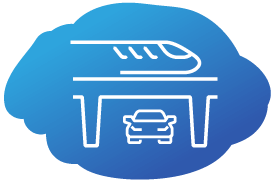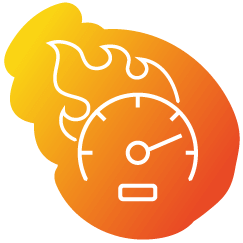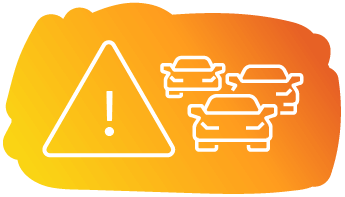Get the Facts:
California High-Speed RailDispel the myths about high-speed rail in California The California High-Speed Rail Authority (Authority) is responsible for planning, designing, building and operating the first high-speed rail system in the nation. High-speed rail will connect California’s megaregions, starting with the Merced to Bakersfield line as the first part of a building block approach. This high-profile project has generated significant publicity, leading to speculation and rumor. It is important to separate fact from fiction.
SustainabilityConstructionMerced to BakersfieldCommitment to SF to LA
Sustainability
Myth: Building high-speed rail causes more pollution than it will save.

Fact:
Contract requirements dictate our construction sites have significantly better air quality than the California average. Our contractors use Tier 4 on- and off-road vehicles and technology to reduce nitrogen dioxide emissions. Site emissions are 60% lower than the state average.
The Authority has received the Envision Platinum rating from the Institute for Sustainable Infrastructure, their highest-level award.
Myth: High-speed rail causes sprawl.

Fact:
More than $10 million in funding has been awarded for station area planning efforts, which will help create thriving and sustainable station area districts.
Planning among key cities creates meaningful connections and economic opportunities.
Myth: Investing Cap-and-Trade proceeds in high-speed rail has produced no results.

Fact:
The Authority ensures that Cap-and-Trade funding is invested in disadvantaged communities in California. In FY 2021-2022, 62% of total project expenditure occurred in disadvantaged communities in California, spurring economic activity in these areas.
Of the over 770 small businesses participating in the high-speed rail program, 262 are Disadvantaged Business Enterprises. Over 11,000 jobs have been created to work on building high-speed rail.
Myth: High-speed rail will be a drain on the power grid.

Fact:
High-Speed Rail will run on electricity supplied entirely from renewable sources.
The Authority is committed to using 100% renewable energy to operate our trains and facilities.
Myth: High-speed rail does nothing to reduce greenhouse gas (GHG) emissions now.

Fact:
At this very moment rail crossings throughout northern and southern California are being upgraded or eliminated. This reduces traffic congestion, improves safety and cuts GHG emissions from idling vehicles.
A single rail crossing can cause up to 45 days of stopped traffic per year, which results in about 1,800 tons of GHG emissions annually.
Myth: California could make better transportation investments.

Fact:
Transportation accounts for the majority of emissions in California, and high-speed rail will help the state achieve its long-term climate goals by reducing transportation emissions. High-speed rail is a critical part of California’s sustainable transportation network. The goals of high-speed rail are reducing congestion and pollution while improving mobility and increasing access to jobs and affordable housing.
As California’s population rises and our economy continues to grow, high-speed rail is the only mode that meets every one of these goals.
Construction
Myth: High-speed rail will be a train to nowhere.

Fact:
The California high-speed rail system will connect 6 of the 10 largest cities in the state.
Myth: No one rides trains anymore.

Fact:
Amtrak’s California corridors are continuing to increase ridership post-pandemic, with over 3 million riders in 2022, an increase of 85% over the previous year.
Myth: High-speed rail will not be high-speed.

Fact:
In blended/shared corridors, trains will be slowed to 110 miles per hour, as required by regulations.
However, speeds will top 220 miles per hour in other areas.
Myth: California High-Speed Rail will be diesel-powered.

Fact:
It will be all electric all the time.
High-speed rail in California will run on 100% renewable energy.
Myth: High-speed rail is a solution in search of a problem.

Fact:
California’s population is projected to grow to more than 44 million by 2050. Transportation is a key contributor to emissions, and Los Angeles and San Francisco rank among the most gridlocked U.S. cities.
The high-speed rail system is a key component of achieving net-zero emissions by transforming and reducing greenhouse gas emissions in the transportation sector, helping California achieve its climate goals.
Merced to Bakersfield Line
Myth: High-speed rail is dead in California.

Fact:
Our 2023 Project Update Report presents our vision for initiating high-speed rail service in California as soon as possible while positioning ourselves to construct additional segments as funding becomes available.
It is our goal to procure, manufacture, and deliver trainsets for testing in the Central Valley by 2029.
Myth: No one is going to ride high-speed rail if it’s just in the Central Valley.

Fact:
The 171-mile line from Merced to Fresno to Bakersfield connects the three largest cities in California’s Central Valley, a region of about 6 million people, including three major California universities.
That’s more people than 15 states currently have (Wyoming, Vermont, Alaska, North Dakota, South Dakota, Delaware, Rhode Island, Montana, Maine, New Hampshire, Hawaii, Idaho, West Virginia, Nebraska, New Mexico). It will also connect major California universities like UC Merced, Fresno State, and CSU Bakersfield as well as local community colleges in the region.
Myth: There’s no way to get from the Central Valley to San Francisco or Los Angeles.

Fact:
As part of the statewide rail modernization plan, high-speed rail will become the backbone of rail transportation in California.
It will allow for convenient connections including the Altamont Corridor Express service in Merced, which will soon have service to San José and the east Bay Area, the Amtrak San Joaquins service to Oakland and Sacramento, and connections from Bakersfield to Southern California.
Myth: High-speed rail is just a jobs program.

Fact:
High-speed rail is creating jobs and stimulating California’s economy, but that’s only part of the story.
There are currently over 30 active construction sites spanning 119 miles from north of Fresno to north of Bakersfield, and the 3,700 foot Cedar Viaduct was completed this summer.
Myth: High-speed rail has given up on San Francisco and Los Angeles.

Fact:
The Merced to Bakersfield line is the first building block for delivering high-speed rail passenger service in California. While we build that line, we are also advancing design and environmental work statewide to prepare to expand the system to the Bay Area and to Los Angeles and Anaheim, as funding becomes available
The Authority continues to invest in projects statewide that provide near-term regional mobility benefits and lay the foundation for high-speed rail service, including the Caltrain Electrification Project in Northern California and Link US at Los Angeles Union Station.
Myth: High-speed won’t go past the Central Valley.

Fact:
High-speed rail is starting with an initial 171-mile segment that will extend from Merced to Bakersfield. At the same time, we are continuing to move forward with environmental clearance in Northern California and Southern California to get these project sections ready for construction.
We have cleared both Northern California sections and two of the four Southern California sections. We will be presenting final environmental documents for Palmdale to Burbank in 2024 as we work to advance Los Angeles to Anaheim.
Commitment to SF to LA
Myth: High-speed rail won’t reach full environmental clearance.

Fact:
422 miles of the high-speed rail project’s 500-mile Phase 1 alignment from San Francisco to Los Angeles/Anaheim has received environmental clearance, with 119 miles in active construction. The Authority is committed to clearing the entire 500 miles of the system from San Francisco to Los Angeles/Anaheim. Staff at the Authority are pushing to complete the remaining environmental documents by 2025. Once completed, further work can be done to refine project configurations, map the needed right of way and other pre-construction activities.
Myth: No progress on high-speed rail is being made in Northern California.

Fact:
The Authority has completed several funding agreements in Northern California to lay the foundations for high-speed rail service and provide near-term regional mobility benefits. The Authority has contributed $714 million towards Caltrain’s Peninsula Corridor Electrification Project, electrifying and upgrading 51 miles of track between San Francisco to San Jose, bringing high-speed rail service to the Bay Area and improving Caltrain’s efficiency, capacity, safety and reliability.
Additional efforts such as grade separation at San Mateo’s 25th Avenue, the construction of the Salesforce Transit Center in San Francisco, the Downtown Extension Project and planning at San Jose’s Diridon Station are essential elements to completing the Silicon Valley to Central Valley Line.
Myth: No progress on high-speed rail is being made in Southern California.

Fact:
The Authority is working with Southern California partners to prepare the region for high-speed rail service. The Authority has committed $423 million towards modernizing the Los Angeles Union Station, preparing the station for high-speed rail and other improvements made under the Link Union Station (Link US) project.
Additional preparatory efforts in Southern California include connecting Brightline West’s planned Las Vegas high-speed rail project with our SF to LA/Anaheim route, coordinating with BNSF Railway and other stakeholders to electrify tracks on a shared corridor between Los Angeles and Anaheim, funding a grade separation for the Rosecrans/Marquardt intersection in Santa Fe Springs, and planning station design and regional connectivity with the city of Palmdale.
The California High-Speed Rail Authority makes every effort to ensure the website and its contents meet mandated ADA requirements as per the California State mandated Web Content Accessibility Guidelines 2.0 Level AA standard. If you are looking for a particular document not located on the California High-Speed Rail Authority website, you may make a request for the document under the Public Records Act through the Public Records Act page. If you have any questions about the website or its contents, please contact the Authority at info@hsr.ca.gov.

